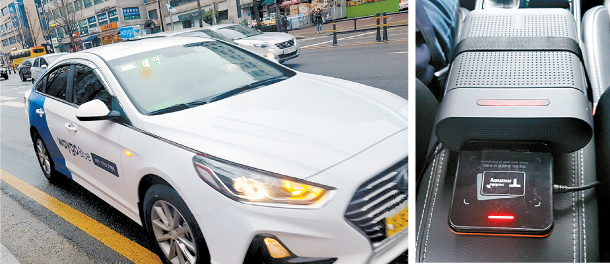Waygo Blue taxis come at a price

A Waygo Blue taxi, left, and an air purifier installed inside it. [PARK MIN-JE]
Waygo Blue claims to offer a premium ride and guarantees to take any passenger even if the destination is very nearby. (Taxis in Korea frequently reject customers if the destination is too close.)
Tago Solutions is partnered with 50 taxi companies, so Waygo Blue is not competition for licensed taxi drivers as ride-hailing services are. It’s basically a new platform to connect taxis already on the road and passengers.
“Our cab drivers trained for this special service will offer a new type of experience,” said Oh Kwang-won, head of Tago Solutions. “Just like Starbucks, where people can experience better service, we will raise the reputation of our brand by providing a satisfying experience to every passenger.”
Waygo Blue charges the usual taxi fare with an additional 3,000 won ($2.60) charge for the call connecting the passenger and taxi. Adding to the 3,800 won basic taxi fee in Seoul, the price for a Waygo Blue ride starts at 6,800 won.
To check out the new service, a JoongAng Ilbo reporter called Waygo Blue to travel from Ogeum-dong in Songpa District, southern Seoul, to Jamsil Station, which is a 3.2 kilometers distance (1.99 miles).
At 7:44 a.m. on Thursday, this reporter opened Kakao T, Kakao’s taxi-hailing app. After entering the destination and selecting Waygo Blue from every Kakao T service, a notice appeared reading: “Requesting a Waygo Blue, applying 3,000 won fee. A 2,000 won commission is imposed if there’s a cancellation one minute after a taxi has been allocated.”
Luckily, a Waygo Blue that was nine minutes away was matched.
Waygo Blue is its initial trial service and currently only has 100 vehicles deployed. Due to this, not every passenger gets lucky with Waygo Blue.
The day before at 8 p.m. in Gangnam District, southern Seoul, the same reporter called Waygo Blue for 10 minutes but was not allocated a taxi. A text appeared reading, “There isn’t an available Waygo Blue.”
After waiting nine minutes, a white vehicle with Waygo Blue written in blue letters on its side arrived. Looking at the vehicle from the front, it was not easy to differentiate from an average taxi.
Inside the Hyundai Moto Sonata, the report couldn’t tell much of a difference from an average taxi except the vehicle was obviously new. A competing taxi-hailing service called Tada distinguished itself from existing taxis by offering vehicles that can fit 11 passengers.
The car was pleasant inside. The seats and floor were neatly cleaned. An air purifier in the middle of the front two seats was running.
Apart from asking the exact location to get off and the driving route, the driver didn’t speak at all. He was wearing a uniform.
Except for sounds from the taxi-hailing app, the only sound in the car’s interior was classical music.
The taxi moved so slowly that the reporter started to feel frustrated. For the sake of offering a premium driving experience, the driver seemed to be denying himself the impatient quirks of normal taxi drivers - accelerating fast, cutting into lanes - and just followed a long line of cars in a lane. The driver never honked.
At the destination, the meter showed 6,000 won after around 10 minute of riding. Adding up the call fee, the total cost was 9,000 won.
The reporter felt the extra 3,000 won was a bit of a waste. A normal taxi could have possibly been even faster. Waygo’s proudest claim of not denying any passenger doesn’t mean much when there are only 100 Waygo Blue taxis.
But Waygo could prove itself in the future when it has many more taxis on the roads - and when a customer is willing to pay extra for a stress-free ride when taxis are hard to find.
BY PARK MIN-JE [jin.minji@joongang.co.kr]










with the Korea JoongAng Daily
To write comments, please log in to one of the accounts.
Standards Board Policy (0/250자)